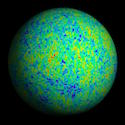Evolution of the caracteristics of the Covariance Matrix with nSide?
date:27/01/09
CONCLUSION:
- For the diagonal of the covariance matrix, the variance of the offsets is correlated to the weight (invert of the number of sample in the ring) of this ring. Indeed, the error on the offset is smaller if there is more sample contributing to the estimation of this offset.
more sample <=> low weight & more sample <=> low error
Nevertheless, on the plot diag vs weight, it seems that there is a splitting. See reflexion about it on
Explain Split
- For the width of the diagonal of the correlation matrix, we can see that the width is decreasing with nSide as expected.
Bolometer 217-5a (the other caracteristics of the data are at nPixRange)
The different nSide values are: 128,256,512,1024,2048
Legend for the following graphs:
| purple | 128 |
| blue | 256 |
| green | 512 |
| orange | 1024 |
| red | 2048 |
Profil of the Covariance Matrix Diagonal for different nSide.
The x-axis is the ring index (0 correspond to ring 580 and the last index correspond to 13098). | Weights of rings (between ring 580 and 13098).
The weight for a ring is worked out as the inverse of the sum of the number of sample of each pixel in this HPR.
weight for ring i = 1 / (SUM (number of sample of pixel p)) for pixels p of the HPR i
The hits are read in
'/space/dmc/m2db/DATA/bench6_HPR_2048_GALACTIC/217-5a_W_TauDeconv_m2db_NOV08_noPS_hit' |
 |  |
| Covariance Matrix Diagonal vs Weights of rings. | Same graph, zoomed! |
 |  |
| Zoom of the Antidiagonal of the covariance matrix around the index of the intersection with the diagonal (index ~ 6260) in logscale. | Zoom 2 of the Antidiagonal of the covariance matrix around the index of the intersection with the diagonal (index ~ 6260) in logscale. |
 |  |
CORRELATION MATRIX
Zoom of the Antidiagonal of the correlation matrix around the index of the intersection with the diagonal (here it is index=0) in logscale.
Somewhere else off the antidiagonal
It can be seen on the correlation matrix (see below correlation matrix for nSide=128) that the diagonal width is changing along the diagonal.
Here after is the comparison of the diagonal width for a slice where the diagonal width seems maximal and for the antidiagonal slice.
Correlation matrix (after a decrease of the resolution) for nSide=128
The longest black line is the antidiagonal. The second one is the slice where the diagonal width is important.
| Profil of the diagonal width for the different nSide value for the antidiagonal | Profil of the diagonal width for the different nSide value for the shorter slice (wider diagonal) | Profil of the diagonal width for the different nSide value and for the two slices (antidiagonal direction) |
 |  |  |
Profil of the diagonal width for nSide=128 and for different slices (antidiagonal direction)


















